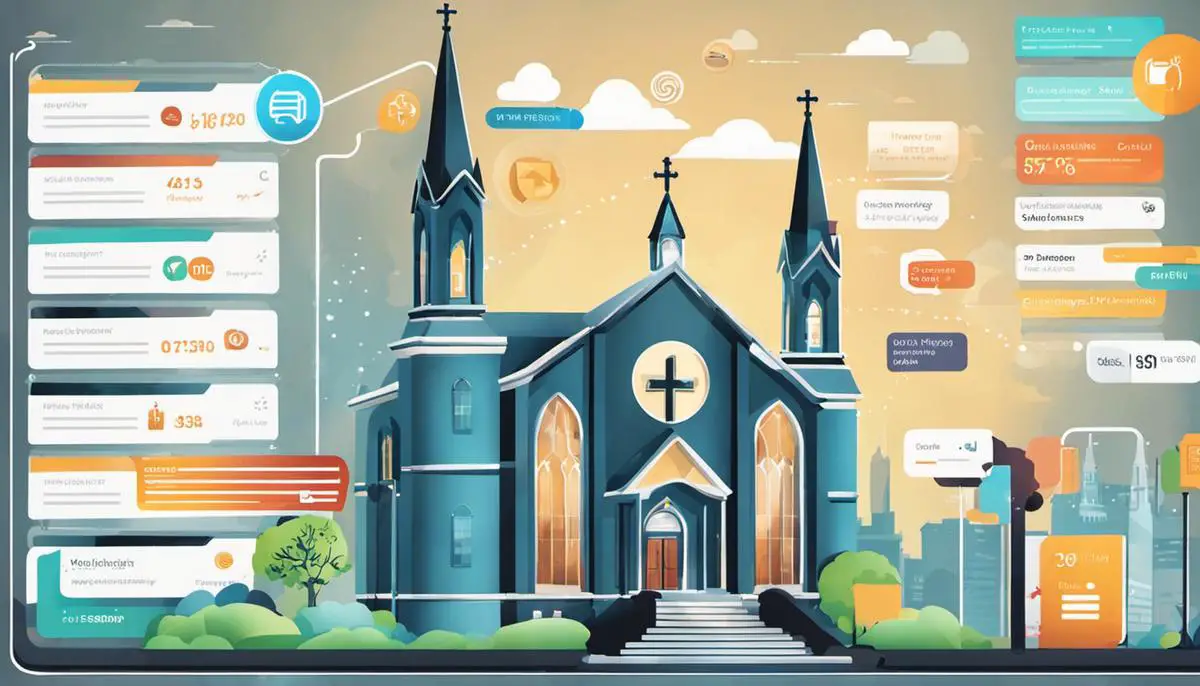In the fast-paced digital world of the 21st century, every sphere of life, including religious institutions, has experienced the transformative impact of technology. More specifically, mobile applications have significantly redefined the methods and efficiency of church management. Abandoning the old school, paper-pen-based administrative strategies, churches are now shifting focus towards cutting-edge technologies to streamline their operations.
This towering collaboration of faith and technology revolves around a more sophisticated yet convenient approach to church management. It enhances communication within the community, makes financing more transparent, and provides a platform for maintaining a virtual sermon archive. Indeed, the adoption of mobile applications for church management is carving a new path for religious organizations to effectively engage with their congregations, ensure efficient financial management, and facilitate seamless event scheduling.
Importance of tech in church management
Mobile Apps: The Revolutionary Game-changer in Modern-day Church Management
While advancements in technology have disrupted several industries, faith-based organizations, particularly churches, are not exempt. A standout includes the increasing incorporation of mobile applications into church management, proving to be more than a passing trend – it’s a revolutionary global shift.
Mobile apps for church management aren’t merely about optimizing administrative functions or broadcasting services online. In essence, the incorporation of these modern tools reflects the church’s recognition of evolving societal trends and a willingness to meet their congregations right where they are – in the digital space.
So why are mobile apps essential in modern-day church management?
#1 Enhancing Community Engagement
Traditionally, church engagement was confined within the walls of the pulpit and parish. But today’s tech-savvy congregations call for a more fluid interaction, achievable through mobile apps. Regular updates, bible readings, prayer calendars, and community events updates at the tap of a button help foster a more engaged fellowship, bridging the gap between Sundays.
#2 Streamlining Administrative Efficiencies
From membership management to event planning and tithing, mobile apps help automate many administrative tasks that otherwise require extensive manual input. The streamlining of these tasks not only reduces possible errors but frees up more time for the church’s primary mission – ministering to the people.
#3 Expanding Reach and Accessibility
For a church to grow, its message needs to reach beyond its physical boundaries. With mobile apps, services can be streamed, sermons can be downloaded, and bible studies can be conducted virtually, extending the church’s reach to global audiences and ensuring accessibility for all, including those who may be physically unable to attend services.
#4 Facilitating Digital Tithing
Digital culture insertion is incomplete without recognizing the evolution of giving trends. Physical collection of tithes and offerings is becoming less prevalent as more people turn to cashless transactions. Integrating digital tithing into church management apps eases this process for members and increases overall donations, with features that can automate recurring giving.
#5 Promoting Spiritual Growth
Ultimately, the church serves to foster spiritual growth. Mobile apps, through personalized bible study plans, sermon archives, and meditation guides can provide the resources necessary for the congregation to deepen their faith, even outside church hours.
While the topic of technology in the church may stir varied responses, it’s undeniable that with the right balance, the incorporation of solutions like mobile apps can strengthen the church community, ensuring the church remains relevant and accessible in our increasingly digital society. Tech adoption doesn’t signify an erosion of tradition; rather, it signals the church’s readiness to walk alongside their congregation towards our shared future.
Embracing innovative solutions is no longer just about staying on trend – it’s about thriving in a modern world. The church, like all other sectors of society, must acknowledge this necessity, ensuring they are not just surviving in the digital age, but indeed, prevailing.

Key features of mobile apps for church management
Essential Criteria for Effective Church Management Mobile Apps
To optimize church operations with technology’s assist, selecting an app that covers the broad function of church management is crucial. Beyond bolstering community engagement, promoting spiritual growth, or easing administrative tasks, there are additional features that shouldn’t be overlooked. Here are five key aspects to watch for when shopping for a church management mobile app.
-
All-in-One Capability: To maximize its potential, a church management application ought to be an all-in fulfilling center. It should merge volunteer scheduling, event management, member’s directory, check-in systems, and more under a single, convenient platform to empower leaders and lay members. An integrated solution ensures that data communication is smooth, navigations are easy, and management tasks become seamless.
-
Security and Data Protection: Paramount when considering any tech application is the assurance of data security and confidentiality. Churches often handle sensitive information of their members; therefore, the application chosen should have robust security features. These might include end-to-end encryption, two-factor authentication, and regular security audits. Trustworthiness enhances members’ confidence in the church’s digital operations.
-
User-Friendly Interface: Effectiveness in application utilization relies heavily on its ease of use. The app design should be clean, intuitive, and straightforward to ensure a swift learning curve for users of all tech-levels. A user-centric design will promote increased application usage, thereby amplifying its return on investment.
-
Cost Efficiency: Budget friendly applications with efficient cost-to-benefit ratios are highly desirable. An excellent church management app should deliver high-end solutions without excessively straining the church’s financial resources. The balance between premium features and budget management cannot be overlooked.
-
Scalability: The church management application should be flexible enough to accommodate the church’s growth. Having a scalable solution offers uninterrupted operations, regardless of the church size or congregational complexity. Whether the church experiences significant growth or a need to downscale, the application should adjust effortlessly.
In summary, it is wise to understand that every church’s needs are distinct and are most likely to evolve over time. Therefore, the ideal church management application should be comprehensive, user-friendly, secure, cost-effective, and scalable. Consider these criteria, and making the choice will be more straightforward, ensuring the app becomes a reliable companion in achieving your church’s key objectives.

Comparison of leading church management mobile apps
In assessing mobile apps for church management, it is important to gauge how they align with the modern demands of churches. Since we’ve already delved into topics like community engagement, administrative efficiencies, reach, digital tithing, and spiritual growth, let’s dive into other critical aspects such as all-in-one capability, security, user interface, cost, and scalability.
An app that can fulfill multiple tasks within a single platform encapsulates the idea of an all-in-one solution. Whether it’s managing events, processing donations, or conducting live streaming, top apps like ChurchDesk, and EasyTithe demonstrate a compelling capability to conduct several tasks within one ecosystem. This not only improves productivity and efficiency but also saves time for the church staff.
In the era of Internet fraud and data breaches, data security cannot be overlooked. Apps such as Aware3 and Tithe.ly take security seriously with encryption layers that ensure the integrity and confidentiality of data. It’s worth noting however, that despite adhering to stringent data protection regulations, no app can guarantee 100% security. Therefore, those using these tools should also be conscious about safeguarding their sensitive data.
User experience and interface play a fundamental role in adoption rates. An application needs to be intuitive, easy to learn, and useful to different age brackets in the congregation. Though app interface preference can vary based on individual needs, PushPay and Church Community Builder stand out due to their emphasis on user-centered design. They provide an intuitive interface that even non-tech-savvy users can navigate effortlessly.
Cost efficiency is another vital factor, as churches often operate on lower budgets. Fortunately, several apps offer different pricing models catering to varying financial abilities. Givelify, for instance, offers a free package for small churches which then scales up based on usage. Other apps like Breeze and EasyChurchTools provide competitive pricing with an extensive range of features, ensuring churches get value for their investment.
Finally, scalability matters. As the church grows, so must the technology. Church Management Software (ChMS) like FellowshipOne and Servant Keeper are renowned for providing tools and features that cope with growth, allowing for seamless scaling as the congregation expands.
In conclusion, multiple church management apps strive to stand out among their competitors, each carrying its unique features and performance advantages. It will ultimately depend on the specific needs of the ministry to decide which app suits them best. The key is to note that the ideal app should balance all these factors to offer an effective, efficient, and scalable solution that enhances church management in our digital era.

Implementation and adoption challenges
Integration Resistance and Technology Acceptance
In discussing possible obstacles in integrating mobile apps into church management, the first issue to tackle often comes from within – resistance to change. While some congregants and church management are excited about the possible benefits of technology, others may be hesitant about abandoning traditional methods. This result rarely stems from an outright rejection of technology but more commonly signals a lack of understanding of how these tools may benefit church operations. As with any tech product, user education is crucial in overcoming this barrier.
Drop in Personal Connection
Another potential obstacle is the perceived loss of personal connection. Churches, at their core, are communities bound together by shared faith and values. The fear here is that by introducing technology, instead of fostering more substantial relationships, could make interactions feel less personal and move away from a community spirit. Communicating the benefits and assurances that these platforms aim to enhance, not replace, personal connections, could alleviate this concern.
Digital Divide
Not all members of a congregation will have equal access to smartphones or reliable internet, leading to another obstacle known as the digital divide. The inability to ensure equal access to the technology for everyone poses an ethical challenge. To respond to this, churches may look into providing resources and support for members who might not have these tools readily available.
Transition and Training
When integrating any new technology, there comes the necessary task of transitioning and training. Teaching church management and members to effectively use an app could be time-consuming and challenging, particularly if they are unfamiliar with similar platforms. Careful planning, along with designing training modules that cater to a variety of tech-literacy levels, should be considered to overcome training problems.
Tech Support and Maintenance
Lastly, any technology comes with the potential for bugs, crashes, and other unforeseen issues. Churches would need to be prepared for these instances with a reliable tech support team to address these issues as they arise. Maintenance, updates, and continuous examination of user feedback should be performed to help ensure the app remains secure, scalable, and user-friendly.
It’s clear that incorporating mobile apps into church management can offer myriads of benefits. However, recognizing and addressing these potential hurdles are significant first steps. Tech developers and innovators must work closely with church administrators and their congregations to foster understanding, prepare for the transition, and constantly improve the system. By doing so, it is probable that technology and faith could find a harmonious intersection. This merge should enhance communal bonds, streamline church operations, and eventually, foster spiritual growth.

Case studies on the successful use of church management mobile apps
Moving on to an examination of tangible examples of successful utilization of church management mobile apps, it’s hard to resist looking at large church bodies such as the ‘Life.Church’ that has undeniably leveraged the power of technology to their advantage. As a pioneering organization in the world of church tech, Life.Church has managed to serve millions worldwide due to mobile apps that technologically empower management of their growing populace.
The Church Centers app, used by Gateway Church, is another testament to the effectiveness of mobile app utilization for faith-based organization management. It has helped consolidate essential services including event registrations, group management, and digital check-ins, promoting efficiency and contributing to the Church’s exponential growth since its inception in 2000.
Catholic churches have also not been left behind. The Diocese of Kerry in Ireland, for example, embraced the ‘ChurchApp’. This has been instrumental in managing events, rotas and communication, and has been praised for its ability to centralize vital information, making an otherwise daunting task quite effortless.
Another notable reference is ‘The Potter’s House’, led by Bishop T.D. Jakes, which has commendably adapted to the technological revolution. Utilising a custom church management app, they offer live streaming, archived sermons, and e-giving functions. This versatile approach has dramatically increased the church’s reach globally while maintaining effective management regardless of geographical expansion.
It’s inspiring to see that churches like ‘North Point Ministries’ as well, have leveraged mobile apps for church management. Using the Tithely church management system, they have managed to efficiently track their ministry objectives, effectively handle mega-church data and streamline pastoral care.
These real-world examples undoubtedly prove the power and promise of mobile applications in managing church activities. Embracing this technology for management in religious organizations is no longer a luxury but a necessity for strengthening ministries and amplifying their positive impact on society. However, the unique challenges that come with technology adoption such as resistance to change, maintaining personal connection, navigating the digital divide, and ensuring effective transition and training, as well as reliable tech support should also be competently managed to fully optimize these tech solutions.

While challenges may obstruct the path toward digitization, no transition is ever entirely devoid of obstacles. Potential issues related to cost, technology, or user acceptability can be mitigated by strategic planning and implementations backed by the understanding and flexible mindset of the church members. It is indeed reasonable to note that the results of this transformation are profound, evidenced by real-world case studies of churches who have leveraged the power of mobile apps to optimize their management and operation.
The stories of their journey underline not merely the practical feasibility of this approach, but the remarkable improvements in the effectiveness and efficiency of church management that these mobile applications can engender. In this spirit, the discourse on embracing tech solutions like church management mobile apps is not merely a nod toward modernity, but a leap towards a more connected, transparent, and efficient faith community.













